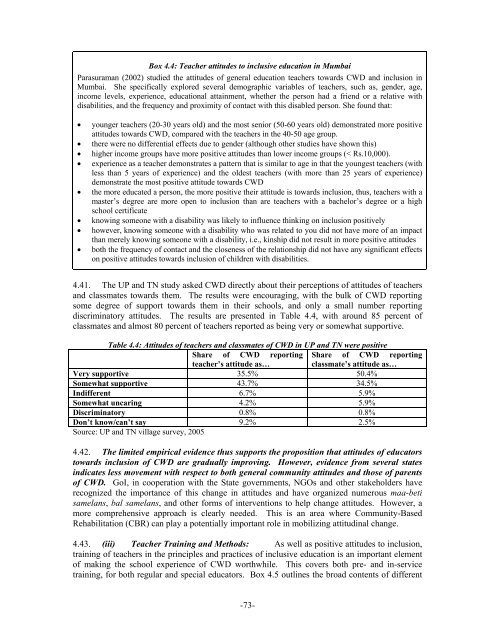People with Disabilities in India: From Commitment to Outcomes
People with Disabilities in India: From Commitment to Outcomes
People with Disabilities in India: From Commitment to Outcomes
Create successful ePaper yourself
Turn your PDF publications into a flip-book with our unique Google optimized e-Paper software.
Box 4.4: Teacher attitudes <strong>to</strong> <strong>in</strong>clusive education <strong>in</strong> Mumbai<br />
Parasuraman (2002) studied the attitudes of general education teachers <strong>to</strong>wards CWD and <strong>in</strong>clusion <strong>in</strong><br />
Mumbai. She specifically explored several demographic variables of teachers, such as, gender, age,<br />
<strong>in</strong>come levels, experience, educational atta<strong>in</strong>ment, whether the person had a friend or a relative <strong>with</strong><br />
disabilities, and the frequency and proximity of contact <strong>with</strong> this disabled person. She found that:<br />
• younger teachers (20-30 years old) and the most senior (50-60 years old) demonstrated more positive<br />
attitudes <strong>to</strong>wards CWD, compared <strong>with</strong> the teachers <strong>in</strong> the 40-50 age group.<br />
• there were no differential effects due <strong>to</strong> gender (although other studies have shown this)<br />
• higher <strong>in</strong>come groups have more positive attitudes than lower <strong>in</strong>come groups (< Rs.10,000).<br />
• experience as a teacher demonstrates a pattern that is similar <strong>to</strong> age <strong>in</strong> that the youngest teachers (<strong>with</strong><br />
less than 5 years of experience) and the oldest teachers (<strong>with</strong> more than 25 years of experience)<br />
demonstrate the most positive attitude <strong>to</strong>wards CWD<br />
• the more educated a person, the more positive their attitude is <strong>to</strong>wards <strong>in</strong>clusion, thus, teachers <strong>with</strong> a<br />
master’s degree are more open <strong>to</strong> <strong>in</strong>clusion than are teachers <strong>with</strong> a bachelor’s degree or a high<br />
school certificate<br />
• know<strong>in</strong>g someone <strong>with</strong> a disability was likely <strong>to</strong> <strong>in</strong>fluence th<strong>in</strong>k<strong>in</strong>g on <strong>in</strong>clusion positively<br />
• however, know<strong>in</strong>g someone <strong>with</strong> a disability who was related <strong>to</strong> you did not have more of an impact<br />
than merely know<strong>in</strong>g someone <strong>with</strong> a disability, i.e., k<strong>in</strong>ship did not result <strong>in</strong> more positive attitudes<br />
• both the frequency of contact and the closeness of the relationship did not have any significant effects<br />
on positive attitudes <strong>to</strong>wards <strong>in</strong>clusion of children <strong>with</strong> disabilities.<br />
4.41. The UP and TN study asked CWD directly about their perceptions of attitudes of teachers<br />
and classmates <strong>to</strong>wards them. The results were encourag<strong>in</strong>g, <strong>with</strong> the bulk of CWD report<strong>in</strong>g<br />
some degree of support <strong>to</strong>wards them <strong>in</strong> their schools, and only a small number report<strong>in</strong>g<br />
discrim<strong>in</strong>a<strong>to</strong>ry attitudes. The results are presented <strong>in</strong> Table 4.4, <strong>with</strong> around 85 percent of<br />
classmates and almost 80 percent of teachers reported as be<strong>in</strong>g very or somewhat supportive.<br />
Table 4.4: Attitudes of teachers and classmates of CWD <strong>in</strong> UP and TN were positive<br />
Share of CWD report<strong>in</strong>g Share of CWD report<strong>in</strong>g<br />
teacher’s attitude as…<br />
classmate’s attitude as…<br />
Very supportive 35.5% 50.4%<br />
Somewhat supportive 43.7% 34.5%<br />
Indifferent 6.7% 5.9%<br />
Somewhat uncar<strong>in</strong>g 4.2% 5.9%<br />
Discrim<strong>in</strong>a<strong>to</strong>ry 0.8% 0.8%<br />
Don’t know/can’t say 9.2% 2.5%<br />
Source: UP and TN village survey, 2005<br />
4.42. The limited empirical evidence thus supports the proposition that attitudes of educa<strong>to</strong>rs<br />
<strong>to</strong>wards <strong>in</strong>clusion of CWD are gradually improv<strong>in</strong>g. However, evidence from several states<br />
<strong>in</strong>dicates less movement <strong>with</strong> respect <strong>to</strong> both general community attitudes and those of parents<br />
of CWD. GoI, <strong>in</strong> cooperation <strong>with</strong> the State governments, NGOs and other stakeholders have<br />
recognized the importance of this change <strong>in</strong> attitudes and have organized numerous maa-beti<br />
samelans, bal samelans, and other forms of <strong>in</strong>terventions <strong>to</strong> help change attitudes. However, a<br />
more comprehensive approach is clearly needed. This is an area where Community-Based<br />
Rehabilitation (CBR) can play a potentially important role <strong>in</strong> mobiliz<strong>in</strong>g attitud<strong>in</strong>al change.<br />
4.43. (iii) Teacher Tra<strong>in</strong><strong>in</strong>g and Methods: As well as positive attitudes <strong>to</strong> <strong>in</strong>clusion,<br />
tra<strong>in</strong><strong>in</strong>g of teachers <strong>in</strong> the pr<strong>in</strong>ciples and practices of <strong>in</strong>clusive education is an important element<br />
of mak<strong>in</strong>g the school experience of CWD worthwhile. This covers both pre- and <strong>in</strong>-service<br />
tra<strong>in</strong><strong>in</strong>g, for both regular and special educa<strong>to</strong>rs. Box 4.5 outl<strong>in</strong>es the broad contents of different<br />
-73-










